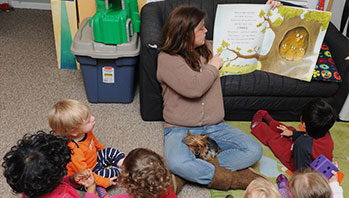- real items or pictures of tumbleweed, saguaro cactus, adobe brick
- The Three Little Javelinas (book)
- The Three Little Pigs (book)
- build
- desert
- materials
- strong
- tumbleweed
MA Standards:
English Language Arts/Literature/RL.PK.MA.1 With prompting and support, ask and answer questions about a story or a poem read aloud.
English Language Arts/Literature/RL.PK.MA.9 With prompting and support, make connections between a story or poem and one’s own experiences.
Head Start Outcomes:
Language Development/Receptive Language Attends to language during conversations, songs, stories, or other learning experiences.
Literacy Knowledge/Book Appreciation and Knowledge Asks and answers questions and makes comments about print materials.
PreK Learning Guidelines:
English Language Arts/Reading and Literature 10 Engage actively in read-aloud activities by asking questions, offering ideas, predicting or retelling important parts of a story or informational book.
Read Together: The Three Little Javelinas #1

© Commonwealth of Massachusetts, Department of Early Education and Care (Jennifer Waddell photographer). All rights reserved.
STEM Key Concepts: How you design and build a structure helps determine how strong it will be; Different materials are useful for making different structures and different parts of structures
ELA Focus Skills: Listening and Speaking, Story Comprehension, Making Connections, Vocabulary
Hold up the cover of The Three Little Javelinas. Tell children that this story is another version of the folktale about the three little pigs.
Then tell them the title of the book is The Three Little Javelinas. Point to the three pigs and say, In Spanish these wild pigs are called javelinas. Have children repeat the word with you (pronounced ha-ve-LEE-nahs). Set a reading focus for children by having them look and listen for how this story is the same as and different from the other versions they know.
Before You Read
- Have children retell the events of the book The Three Little Pigs.
- Hold up the first spread of The Three Little Javelinas and the first spread of The Three Little Pigs by Paul Galdone. Ask children to describe each setting and name any objects they recognize. (sand, rocks, mountains, cactus, grass, trees, hills, fences) Explain that the The Three Little Javelinas takes place in a very hot place called a desert. You may want to show real-life tumbleweed or cactus (without needles) or photographs of a desert to help children visualize the setting of the story.
- As children look at the illustration, ask them to predict what materials the javelinas might use to build their houses.
As You Read
Read slowly and use facial and voice expressions to act out emotions and sound words.
- Pause after you read the spread where the tumbleweed blew on the first javelina. Ask, How is the tumbleweed that blew onto the javelina like the straw that the first pig found? (fluffy, light)
- Pause when the third javelina finds the adobe bricks. Ask, How are the adobe bricks like the bricks the pig used to build his house? (strong, heavy)
- Pause on the page where the coyote blows in the first pig’s house and ask, How is the coyote like the wolf?
After You Read
Talk with children about the story. Help children make connections between the two versions they’ve read.
- What did you like about the story? What was your favorite part?
- How are the materials the pigs use in The Three Little Javelinas different from the materials the pigs use in The Three Little Pigs?
- How are the characters in The Three Little Javelinas the same as those in The Three Little Pigs? How were they different?
Take It Further: Talk with children about different environments and how living things inhabiting those environments meet their needs using what is available to them. Ask children, What kinds of building materials did the javelinas have available to them in the desert? What is a desert like? What kind of house would you want to live in in the hot, dry desert? Introduce other environments, such as arctic environments, tropical jungles, and tundra. Show pictures of the environments and ask children to imagine what materials people and other living things there might use to build with and why.
English Language Learners: Draw out any prior knowledge children may have with the terms javelina, adobe, or other Spanish words in the text.
English Language Learners: Point out the similarity between the pronunciation of the English and Spanish words desert/desierto to help bridge the language gap with new vocabulary.
Adaptation: You may prefer to ask younger children simple recall questions if they are not ready for exploratory thinking.
